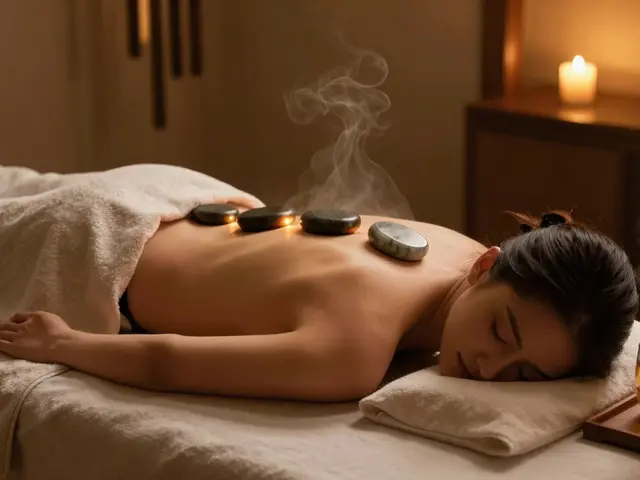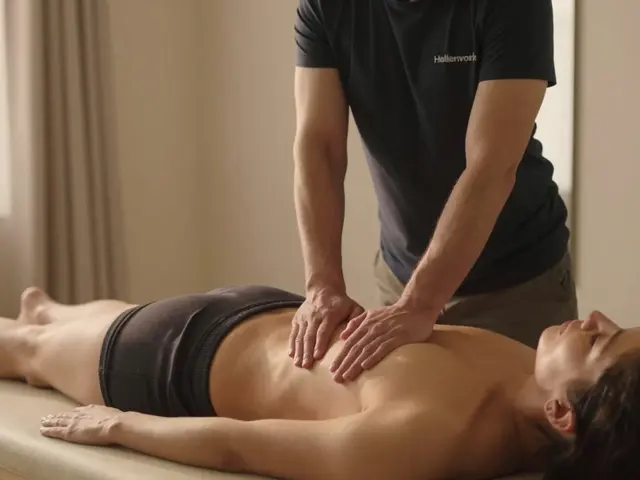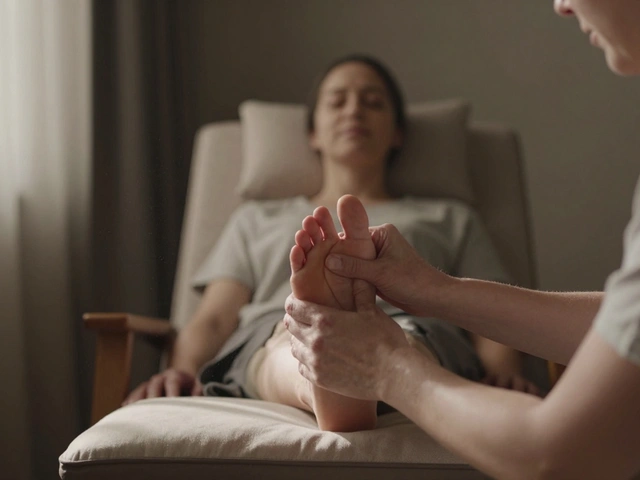You want a love life that feels alive, connected, and not rushed. The problem? Real life gets in the way-work emails, bedtime routines, the never-ending laundry. Tantric massage offers a gentle reset: slow, mindful touch that melts stress and brings you back to each other. It won’t turn your relationship into a rom‑com overnight, and it’s not about acrobatics or anything explicit. It’s about presence, respect, and deep calm-the stuff desire actually thrives on.
- TL;DR: Slow, affectionate touch calms your nervous system and boosts closeness-great for long-term desire.
- Start simple: agree on boundaries, set a 30-45 minute window, focus on breath and slow strokes on shoulders, back, arms, legs.
- Science backs it: pleasant touch activates nerves tied to bonding; mindfulness improves satisfaction.
- Keep it PG: avoid genitals; focus on safety, consent, and connection.
- Consistency beats intensity: once a week for a month can shift how you feel about each other.
What Tantric Massage Really Is (and Isn’t)
At its heart, tantric massage is about presence, breath, and intentional touch. The aim isn’t performance or “finishing.” It’s to tune into your partner’s comfort, pace, and emotions. Think of it as a body-based way to practice mindfulness together.
What it is: a ritual of slow, respectful touch, eye contact, and breathing. You’re learning to read each other-without rushing. What it isn’t: explicit technique, pressure to get aroused, or trying to achieve a “goal.” If anything, it works because you let go of goals for a while.
This approach can improve your love life by tackling the real mood killers: stress, disconnection, and pressure. When you lower stress and increase safety, desire usually has a better chance of showing up.
Quick personal note: I’m a mum in Portsmouth, so my partner and I do this after the kids are asleep and the dishwasher’s on. A lamp, a towel, a little oil, soft music that doesn’t distract-and we’re not trying to make magic. We’re just trying to feel close again. That’s enough.
The Science Bit (Plain English)
Why does this work? Three reasons show up repeatedly in research:
- Affective touch: Slow strokes (about 3-5 cm per second) along the skin activate special nerve fibers called C‑tactile afferents. These are linked to feelings of pleasantness and social bonding (Löken et al., Nature Neuroscience, 2009; McGlone et al., Neuroscience & Biobehavioral Reviews, 2014).
- Stress down, connection up: Partner-delivered massage has been shown to reduce stress, lift mood, and improve relationship satisfaction for givers and receivers (randomized trials reported in PLoS ONE, 2020; Complementary Therapies in Clinical Practice, 2018). Massage more broadly is associated with lower cortisol and improved well‑being (Field, International Journal of Neuroscience, 2014).
- Mindfulness matters: Paying attention to breath and sensation-without judging-has been linked to better desire and satisfaction (Brotto & Basson, Journal of Sex & Marital Therapy, 2014). Slow exhalations can support calm via vagal pathways (Porges, The Polyvagal Theory, 2011).
Put simply: slow touch plus calm breathing tells your body “you’re safe.” Safety is a precondition for curiosity and desire. It’s hard to feel turned on when your brain is in firefighting mode.
Step-by-Step: A Gentle Couples Ritual at Home
This is a PG, beginner-friendly structure. No explicit techniques. No pressure to be “in the mood.” You’re practicing presence.
Before you start, agree on boundaries: clothing level you’re both okay with, areas to avoid (keep it non-genital for this practice), a safe word if anyone wants to pause (“Pause” works just fine), and a time limit.
Supplies you’ll want:
- A towel or blanket you don’t mind getting a little oily
- Neutral body oil (sweet almond, grapeseed, or fractionated coconut). Patch-test for allergies
- One cushion or folded towel for head/hips
- Soft, instrumental music and warm room temperature
- A timer set for your agreed slot (30-45 minutes is great)
Ritual structure (take turns, 15-20 minutes each):
- Arrive together (2 minutes)
- Stand or sit facing each other. Make eye contact. Place one hand on your own chest and one on your belly. Breathe in for 4 counts, out for 6. Do 6 breaths. This helps signal safety.
- Say what you want in one sentence: “I want to feel close.” “I want to relax.” No fixing, just hearing.
- Set consent and boundaries (1-2 minutes)
- Receiver says: “Today I’m okay with touch on my back, shoulders, arms, legs; please avoid X.” Giver repeats back to confirm.
- Agree to non-genital touch. The goal here is connection, not escalation.
- Warm-up touch (3 minutes)
- With clothes on or a towel draped, place your palms gently on the receiver’s shoulders or back. Just hold still for three slow breaths. Stillness first, strokes later.
- Then do long, slow strokes over shoulders, arms, and upper back, moving at a snail’s pace. Think “paint the whole canvas.”
- Full‑body flow (10-12 minutes)
- Use a tiny amount of oil on areas like shoulders, back, arms, calves, and feet. Avoid slippery floors.
- Keep your speed slow and pressure light-to-medium. A good rule: if you’re racing, cut your speed by half.
- Work in broad, continuous strokes rather than pokey or choppy movements. Imagine waves coming to shore.
- Check in quietly: “Is this pressure okay?” Receiver can say, “Softer,” “Slower,” or “Stay.”
- Stay away from areas you agreed to avoid. Keeping that promise is the trust-builder.
- Close the session (2-3 minutes)
- End with still hands: one palm between shoulder blades, one on the lower back or over a towel on the upper arm. Three slow breaths together.
- Giver says what they appreciated: “I loved feeling your breath slow.” Receiver says, “Thank you.” That’s it.
Switch roles if you both want to. If time is tight (hello, weeknights), do 10 minutes one way and swap later in the week. Consistency beats marathon sessions.

Real-World Examples and Scripts You Can Borrow
Not sure what to say or do? Use these simple, non-cringey scripts. Keep your voice soft and your sentences short.
Consent scripts:
- Giver: “I’d like to offer you 15 minutes of slow touch on your back and arms. Clothes can stay on if you prefer. Interested?”
- Receiver: “Yes, please avoid my lower back today. Light pressure.”
- Giver: “Got it. I’ll check in about the pressure after a few minutes.”
Check-in scripts during the session:
- Giver: “Want softer, firmer, or keep as is?”
- Receiver: “Softer and slower.”
- Giver: “Softer, slower. Thank you.”
Closing scripts:
- Giver: “One thing I appreciated was how your shoulders softened under my hands.”
- Receiver: “Thank you for going slowly. I felt cared for.”
Time and space hacks:
- New parents: 8 minutes while the kettle boils. Shoulders today, feet tomorrow. It counts.
- Busy week: schedule a 30‑minute “phone off, lamp on” ritual every Wednesday. If it’s in the calendar, it happens.
- Awkward at first? Use a 3‑song playlist to structure it. When the third track ends, you wrap.
If either of you has a history of trauma or pain, keep the practice extra gentle and predictable. Announce what you’re about to do before you touch. Keep talking. Stop if anything feels off. You can pick this up with a therapist’s guidance if needed.
Checklists, Comparisons, and Pro Tips
Quick setup checklist (print this or save it):
- Room warm, phones off, soft light
- Towel/blanket down; neutral oil ready; tissues handy
- Agree time limit and no‑go zones
- Safe word confirmed (“Pause”)
- Timer set; simple music on
- Three grounding breaths together
Technique cheat sheet (keep it simple):
- Speed: imagine stroking molasses-very slow, steady
- Pressure: light to medium; bones = lighter, muscles = medium
- Direction: long strokes toward the heart on limbs, broad circles on shoulders/back
- Hands: whole‑hand contact is calming; fingertips can be tickly-use sparingly
- Breath: out-breath longer than in-breath (4 in, 6 out) to invite calm
Common pitfalls to avoid:
- Turning it into a task: “I’m doing this to get something later.” Drop the bargaining. Presence is the point.
- Rushing: If you catch yourself speeding up, slow down by half. Then half again.
- Silent confusion: Ask for what you want. Guessing games are cute until they aren’t.
- Boundary creep: If you agreed on areas to avoid, honour that fully. That’s how trust grows.
Comparison table (so you can place this practice in context):
| Practice | Main goal | Touch zones | Pace | Talking | Outcome focus |
|---|---|---|---|---|---|
| Tantric-style couples massage | Presence, bonding, nervous-system calm | Non-genital: back, shoulders, arms, legs, feet | Very slow, rhythmic | Brief check-ins, shared breathing | Connection over goals |
| Swedish massage (spa) | Muscle relaxation, circulation | Whole body (non-genital in professional settings) | Slow to moderate | Minimal | Physical relaxation |
| Sensate Focus (therapy) | Reduce anxiety, rebuild touch tolerance | Starts non-genital; may progress in phases under guidance | Slow, attentive | Structured feedback | Comfort with touch, later desire |
Pro tips from experience:
- Micro-rituals make it sticky: light the same candle or start with the same three breaths so your bodies learn “oh, this is the safe time.”
- Keep the room slightly warmer than you think. Cold skin tenses up.
- Oil on your hands, not poured on your partner. Less mess, more control.
- Set a clear end to the ritual. Knowing it ends reduces pressure and helps you both relax.
- If giggles happen, let them. Laughter also tells the body it’s safe.
Mini‑FAQ and Next Steps
Is this cultural appropriation? Tantric ideas come from rich South Asian traditions. This guide focuses on respectful, secular principles: consent, breath, presence, slow touch. If you want to go deeper, look for teachers who acknowledge roots and ethics.
How often should we do it? Once a week is a great start. A tiny 10‑minute midweek top‑up helps more than a once‑a‑month marathon.
What oil is best? Simple, unscented oils like grapeseed or sweet almond. If anyone has nut allergies, avoid nut oils. Do a small patch test first.
What if one of us isn’t in the mood? This ritual doesn’t require arousal. You can still do the grounding, the slow touch on shoulders/arms/legs, and the closing. If “no” comes up, respect it and try a five‑minute cuddle instead.
Can we include sexual touch? This guide is about non-genital connection. If you decide to expand later, do it with explicit consent and clear boundaries. Keep checking in.
Should we see a professional? If you’re working through pain, past trauma, or recurring conflicts, a couples therapist or sex therapist can help. In the UK, look for practitioners registered with reputable bodies (COSRT, UKCP, BACP). For bodywork, check clear ethics policies and professional boundaries.
We feel awkward. Is that normal? Completely. New rituals often feel odd the first three times. Stick to the script, keep it short, and let the structure carry you.
Next steps (choose one):
- Starter month: Book four weekly sessions of 30 minutes. Same day, same time. Track how you feel after each session in one sentence.
- Breath upgrade: Add a 5‑minute breathing practice (4 in, 6 out) before touch for two weeks. Notice if your shoulders drop sooner.
- Connection journal: Each write a one‑line “thank you” after sessions. Read them back at the end of the month.
Troubleshooting for common scenarios:
- New parents with no time: Trade 8‑minute sessions on alternate nights. Shoulders only. Timer on. That’s enough to build the habit.
- One partner anxious: Keep lights brighter, stay fully clothed, and name each movement before you do it: “I’m placing my hand on your shoulder now.” Predictability calms nerves.
- Pain or disability: Skip areas that flare symptoms. Use cushions to support joints. Prioritise still touch and breath over strokes. Comfort first.
- Long‑distance: Do a voice call and guide each other in self-touch on safe zones (shoulders, arms) while breathing together. It’s not the same, but it keeps the bond warm.
- Different libidos: Treat this as care time, not a gate to sex. Desire often returns when pressure leaves.
If you remember one thing, make it this: go slowly enough that you both notice the moment shifting-from busy mind to shared breath to “we’re here together.” That shift, repeated, is how your love life gets its spark back.
Research notes (for the curious): affective touch and C‑tactile afferents-Löken et al., Nature Neuroscience (2009); McGlone et al., Neuroscience & Biobehavioral Reviews (2014). Partner massage and well‑being-PLoS ONE (2020); Complementary Therapies in Clinical Practice (2018). Massage and stress hormones-Field, International Journal of Neuroscience (2014). Mindfulness and sexual satisfaction-Brotto & Basson, Journal of Sex & Marital Therapy (2014). Vagal regulation and calm breathing-Porges, The Polyvagal Theory (2011).










